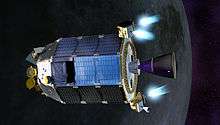OpenLuna
| Abbreviation | OL |
|---|---|
| Motto | Your Moon, Your Mission, Get involved! |
| Type | NGO |
| Legal status | Foundation |
| Leader | Paul Graham |
| Website | openluna.org |
OpenLuna is a program for the exploration of the Moon, based on open source ideologies. It is run by the OpenLuna Foundation, which was founded to set foot on the moon through private enterprise since the Apollo program in the late 1960s through the 1970s. OpenLuna is part of the emerging new-space industry, which is one of the few growing industries in the current economy.
Initial plans call for a stepped program of robotic missions, which will be followed by a short series of manned missions before the construction of a small outpost which will be open for any purpose. Most of the work on the missions is being done on the wiki.
OpenLuna Gemini Mission 1
| Mission type | Messages in space |
|---|---|
| Operator | OpenLuna Foundation |
| Start of mission | |
| Launch date | Unscheduled |
OpenLuna Gemini Mission 1 is an unmanned mission planned by OpenLuna with the cooperation of the PocketQub project with support from Professor Bob Twiggs at Morehead State University Space Science Center in Kentucky. Originally, it was planned as a cooperative mission between OpenLuna and Micro-Space of Denver, Colorado. However, with the recent passing of Richard Speck, Mission 1 was revised to an effort to preserve his work and vision of tiny satellites operating in space.
Mission 1 has been combined with the Launch Team[1] which does not have a definite schedule.[2]
Mission plan
This is a description of the current mission plan.[3]
"Scout" class
The "Scout" class will feature multiple small scout rovers delivered by a single lander as well as a communications satellite that will be placed in orbit around the moon. The lander will "hop" around to deposit the rovers, similar to an upside down candy-dispenser. There will be two of these lander/rover combinations in the initial launch, one being left in orbit until the results from the first landed unit are analyzed. Based on determinations from the science team, the second lander will either land at a secondary search location, and distribute its rovers there, or distribute rovers around the existing sites for greater detail.
"Boomerang" class
The next two missions, to be called "Boomerang" class, will feature a communications satellite and multiple landers. We plan for 180–200 kg of samples returned and a rover that can loiter indefinitely "prospecting" and gathering further information. The landing is planned for the southern pole. We will be looking for water, He-3, and a good location for a future shelter and outpost. Land will be "claimed" for the project (as provided for by international law and treaty, see growing and evolving discussion of lunar and other non-Earthly land ownership debates/policies). Place at minimum one communications satellite in orbit with the first launch. At least two of these missions are planned to give a good spread of target areas and rigorously test the technology. Rock samples will be returned to the University of Western Ontario, CPSX and, after being safely cleared, then distributed to those who requested them or auctioned. Profits from this and other income opportunities will be used to fund the next mission. Media opportunities will include auctioning samples, contests to include students at various levels, naming rights as appropriate, documentary rights, etc.
"Pathfinder" class mission
Presuming satisfactory site characteristics, tests, and technology development, this mission will be manned. A person with a lunar "tent" as a safety stop will stay as long as safely feasible, testing technology and preparing the site for future construction. This first manned lander will be named "Tranquility" in honor of Apollo 11 (and Firefly/Serenity). Formal announcement of outpost construction plans for Phase four. Development of licensed merchandise, mock and real space/surface suits, other things as they are thought of.
"Explorer" class mission
Launch up to three more astronauts (as many as possible given technology and supplies). Bring shelter materials as determined by Phase three and spend approximately one to three days building an outpost. If feasible and safe, leave two volunteers on the surface.
"Shakedown" mission
Launch up to five more astronauts (as many as possible given technology and supplies). Bring shelter materials as determined by Phase four and spend as much as two weeks testing every system by use in the outpost. If feasible and safe, leave a volunteer on the surface. The announcement of the outpost completion will be given out, reservations are offered and use to NASA, ESA, JAXA, ANGKASA other space agencies, and private individuals and organizations.
Further plans
Develop mining, a scientific outpost, in-situ life support as quickly as possible. We will start looking at better surface transport, and a secondary site for a second or third outpost, preferably on the far side for a telescope, or lava tube sites. Work with a launch provider to improve launch and landing capabilities. Work on a capsule to increase crew comfort. Primary concerns will be given to making the facilities self-sufficient, developing infrastructure to further exploration, and Lunar utilization, and working to further educate and inspire the general population.
References
- ↑ http://openluna.org/
- ↑ http://openluna.org/launchteam
- ↑ "Missions". Retrieved 31 March 2012.
Further reading
- Battler, M.M. & Spray, J. (2009). "The Shawmere anorthosite and OB-1 as lunar highland regolith simulants". Planetary and Space Science. 57: 2128–2131. Bibcode:2009P&SS...57.2128B. doi:10.1016/j.pss.2009.09.003.
- Battler, M. M. (2008) "Development of the Anorthositic Lunar Regolith Simulant OB-1". M.Sc. Thesis, University of New Brunswick.
- Battler, M., and Spray, J. (2006) "Physical and chemical characteristics of Apollo 16 lunar highland soil 64500". 69th Metsoc. Abstract 5389.

